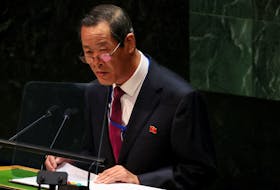FACT: The Holyrood Thermal Generating Station was going to be overhauled or replaced with or without the Muskrat Falls hydroelectric project, at some point. There is a debate around when major investment would have been necessary.
Nalcor Energy board member John Mallam was talking on Oct. 17 at the Muskrat Falls Inquiry about Newfoundland's reliance on generators at the Holyrood power plant, making some of the most pointed comments to date on the power station, including that the plant was "hanging over our heads" in 2012.

Lawyer Geoff Budden questioned Mallam, saying it had been suggested that the island electrical system wasn't going to last another 25 years, and that the Holyrood thermal power plant (key to meeting winter demands on the island) was being "held together with bubble gum."
"It's not far from that," Mallam said with a chuckle as the questions continued.
The units inside Holyrood are beyond their expected lifespan of about 30 years (the youngest being 33 years old in 2012). Operating hours don't quite mean they've been run into the ground, but the question was — and is — how long they can be relied on.
Mallam said you could have added new combustion turbines to the grid to keep Newfoundland powered over the next 30 years of peak demands, but even with new units, the Holyrood plant needs work. As much was said by the Progressive Conservative government during debate around the province's energy options.
In the “isolated island” scenario developed as an alternative to the Muskrat Falls project, paying for the overhaul at Holyrood including environmental upgrades was a factor. As noted in the report by Manitoba Hydro International in late 2012, the option included new small hydro projects and wind power alongside oil-burning generating units. Discussing the replacement of Holyrood's generators, it included a new 170 megawatt (MW) generating unit in 2032, another in 2033 and a third in 2036.
Failures inside the machinery at Holyrood are about more than just cost, given that they become significant risks to safety; while failures in related infrastructure (like in the marine terminal and underground pipelines carrying oil from storage facilities to the plant and generators) become environmental concerns.
Environmental piece
On Oct. 1, former premier Danny Williams reiterated past comments about the Holyrood plant, calling it “antiquated,” and saying he still viewed getting rid of it as a benefit of the Muskrat Falls project. His argument wasn’t all financial or operational.
“There’s the emissions that come from that, and there’s also the health aspects,” he said. “There’s been residents in that area up there that have been concerned about the health aspects up there, so not only are we getting rid of an antiquated facility, we’re also – there is a related health benefit.”
The Muskrat Falls inquiry has spent a lot of time on the review of the Public Utilities Board of an isolated power system versus an interconnected power system. During that review, testimony was given by Holyrood residents including Jack Swinimer (2013), who said residents of the town had been appealing to the government for years for the closure of the oil-fired power generating facility. They voiced concerns about emissions from the plant.
In the context of climate change and carbon emissions, a carbon tax wasn't yet proposed for the province when the decision on Muskrat Falls was made. At this point, it remains unknown how a carbon tax will be applied to the facility, as it continues operating given delays in Muskrat Falls project construction.
The bottom line is environmental considerations were a part of the province's thinking at the time the Muskrat Falls was sanctioned.
Maintained, or not?
A point of difference in testimony at the inquiry was related to when the Holyrood power plant needed to be dealt with, and why it is a problem now from a mechanical and operational point of view.
“We know from the Public Utilities Board that Holyrood wasn’t properly maintained,” said former provincial deputy minister and former city manager Ron Penney, while on the stand Oct. 10.
That’s contradictory to a life-extension study for Holyrood by consultants with Amec, reporting in April 2012. “Holyrood units are considered to be in good condition for their age. They have generally been well maintained and seen moderate re-investment to resolve previous issues.”
Currently, the thermal plant is required to meet the island’s winter peak power needs. It played a role in the significant power failures that became known as #DarkNL and continues to be the main point of uncertainty when it comes to assuring reliability of power for Newfoundland, Liberty Consulting has stated.
“At this time, repair work is ongoing at Holyrood and there is uncertainty about the future full availability of the capacity of these (Holyrood) units. In addition, even if these units are returned to full rated capacity, there is continuing uncertainty, given their age, condition and past performance, on the ability to rely on them for the future until the interconnection with Muskrat Falls,” stated a report from August 2016, looking at the need for added power supply even before new Muskrat Falls hydro power comes online.
“In June 2016, it was announced that the full in-service date for Muskrat Falls, which was originally planned to be in-service for the winter of 2017-18, has been delayed until the winter of 2020-21. This considerably extends the time that the existing thermal units must be available. Hydro’s recent assessment of supply adequacy until the interconnection indicates reliability violations which Hydro proposes to mitigate but not eliminate,” it states.
At the PUB, industrial customers, in particular, have been pressing for more specific information on how the island’s needs will be met over the next few years –—what Newfoundland and Labrador Hydro is planning to spend on Holyrood versus new additions, and when.

![['Complaints about the Holyrood power station have played a part in provincial power supply planning. \n— Telegram file photo']](https://saltwire.imgix.net/holyrood-2012799.jpg?cs=srgb&fit=crop&h=568&w=847&dpr=1&auto=format%2Ccompress%2Cenhance)







